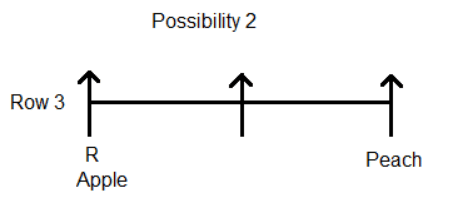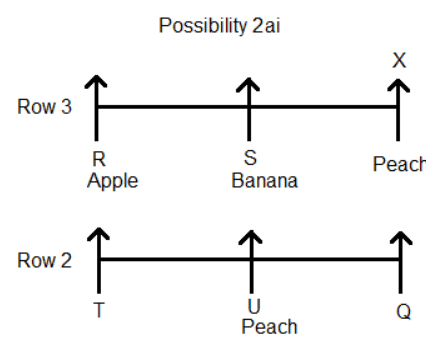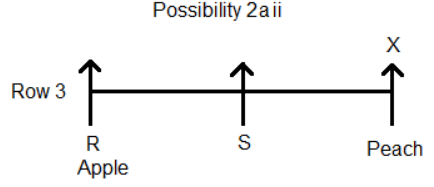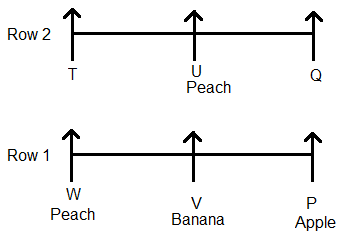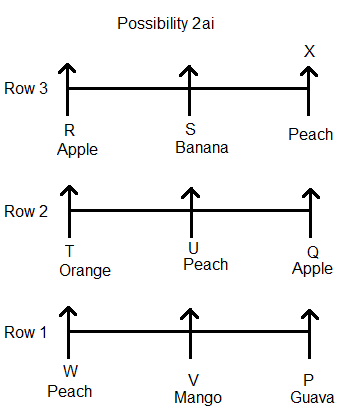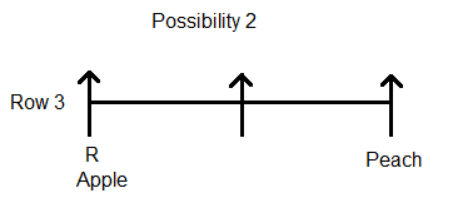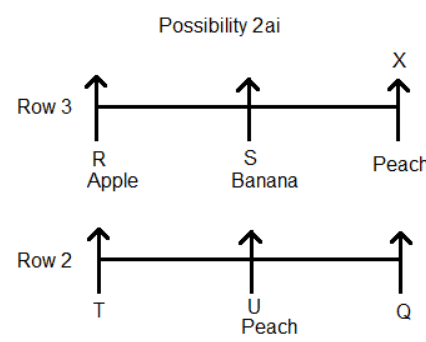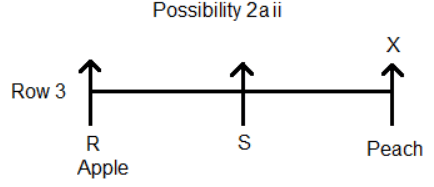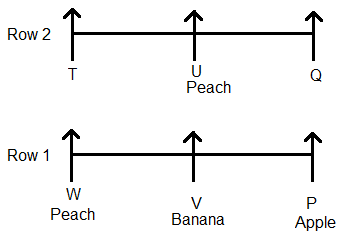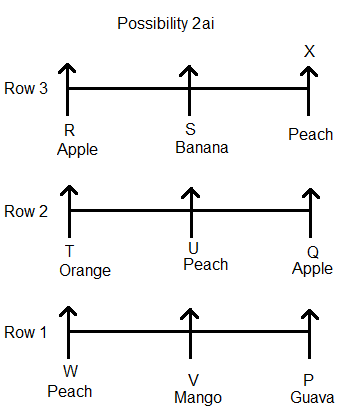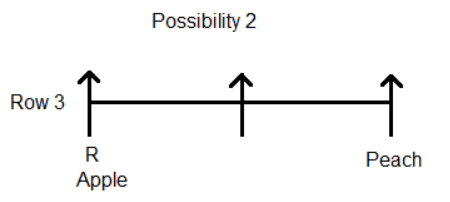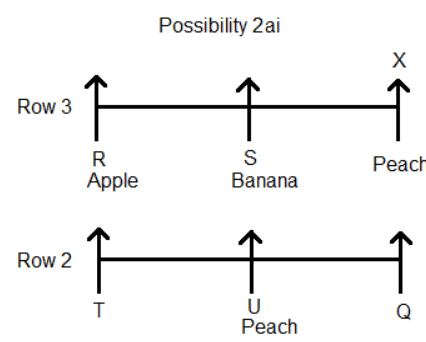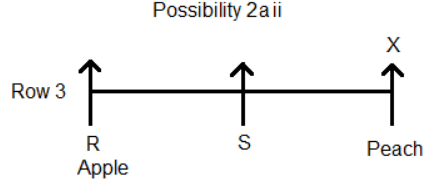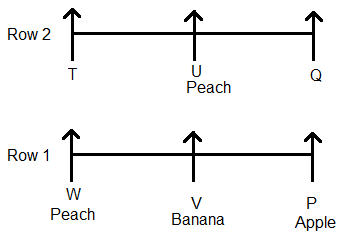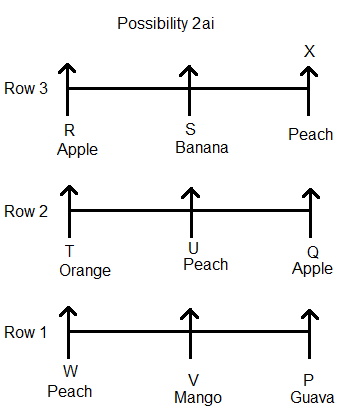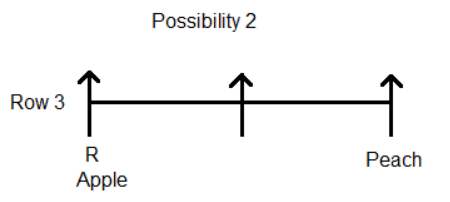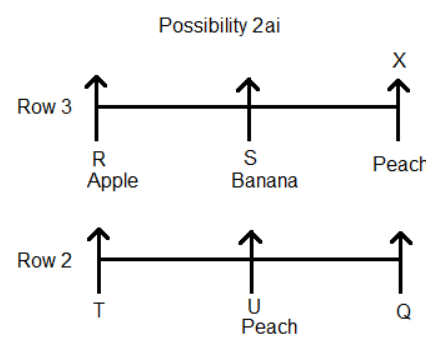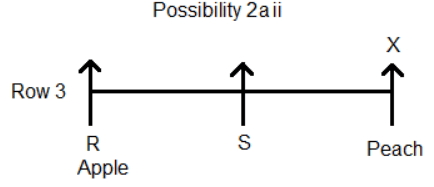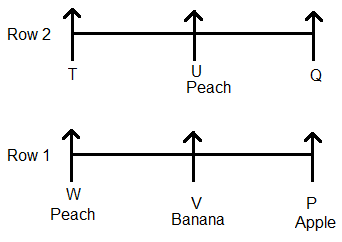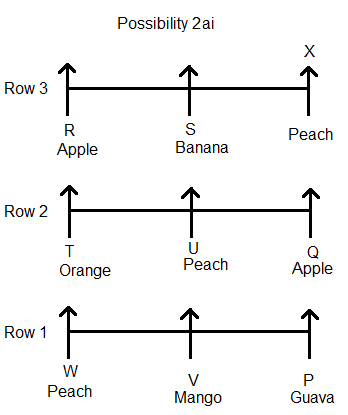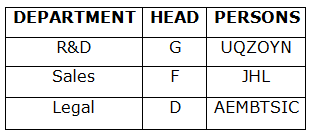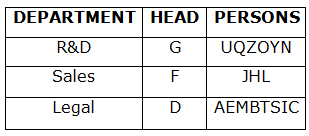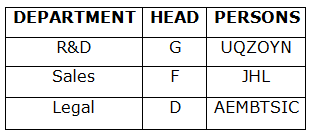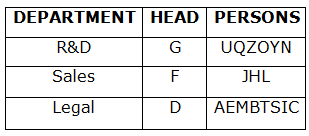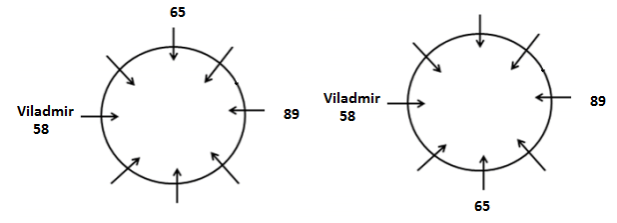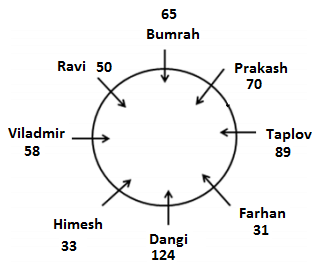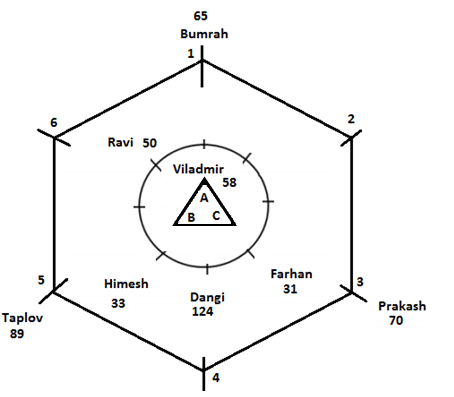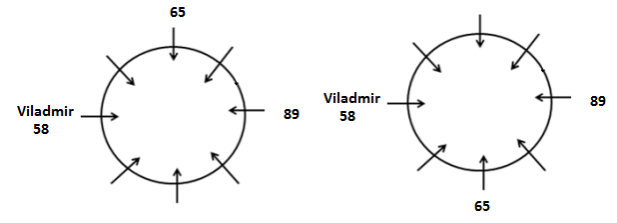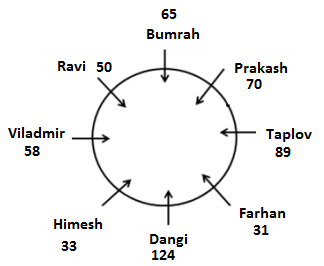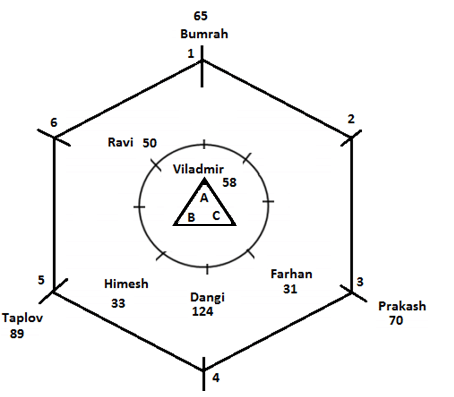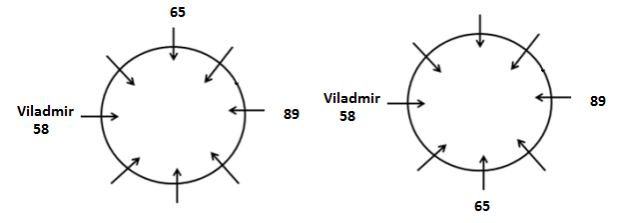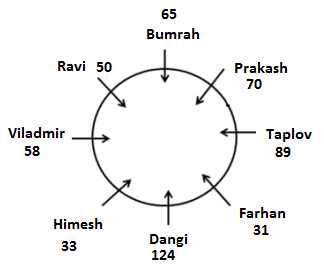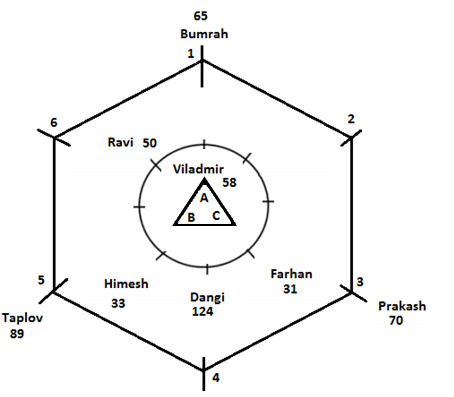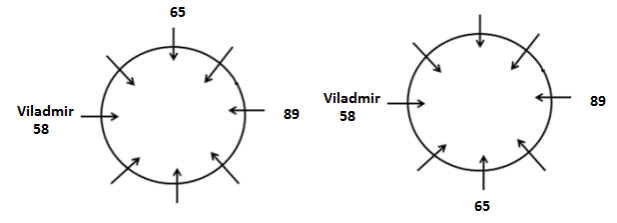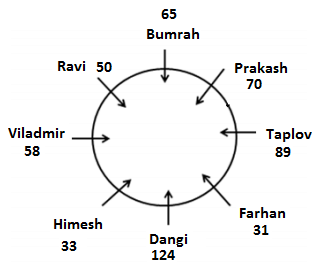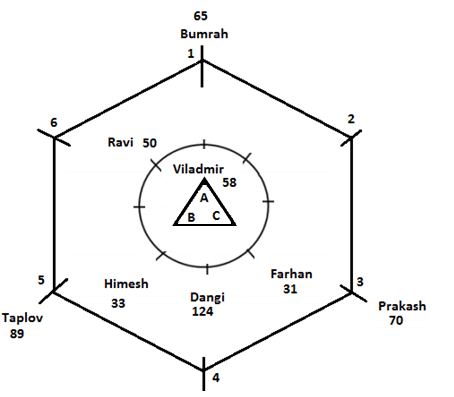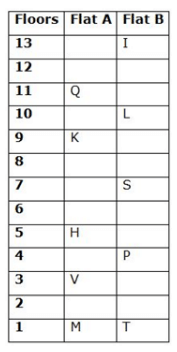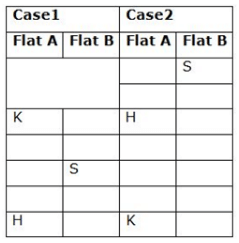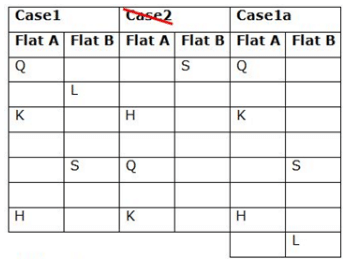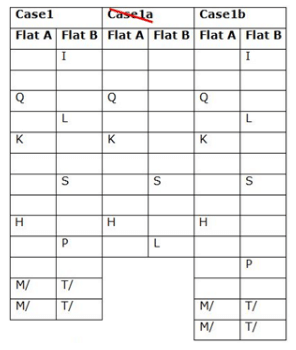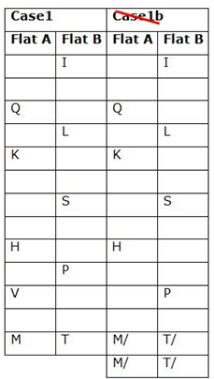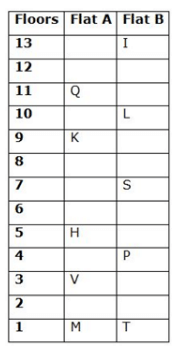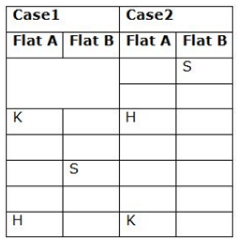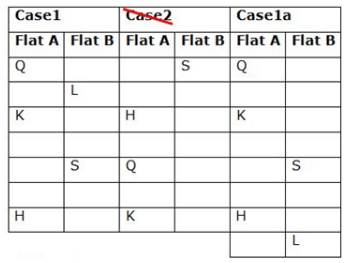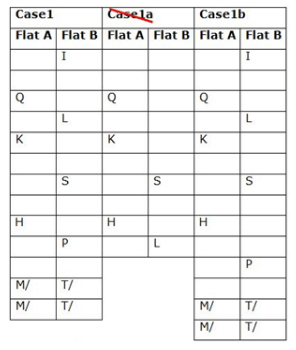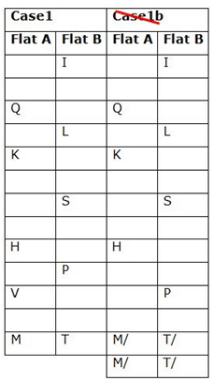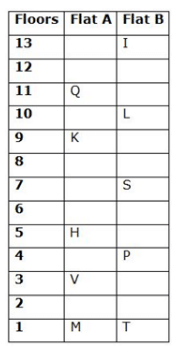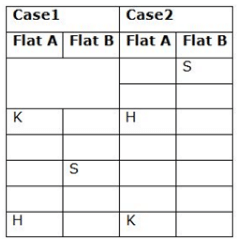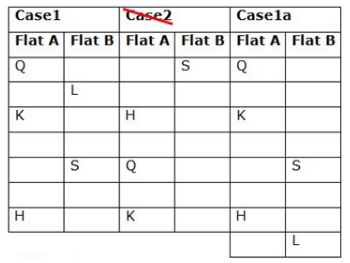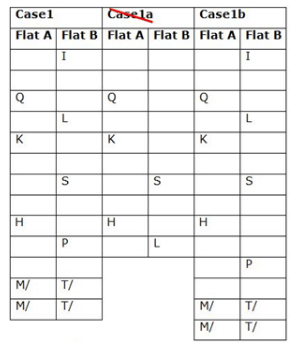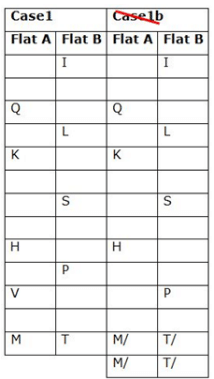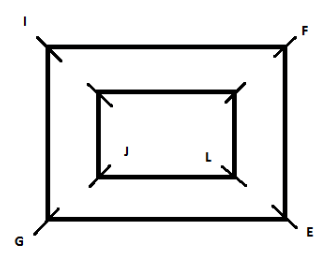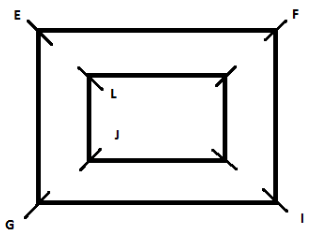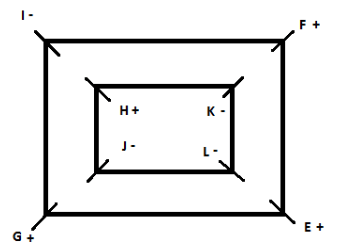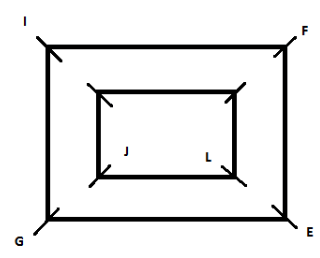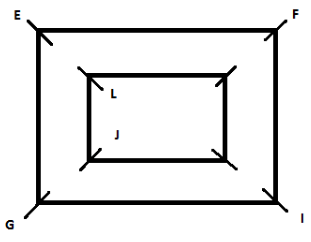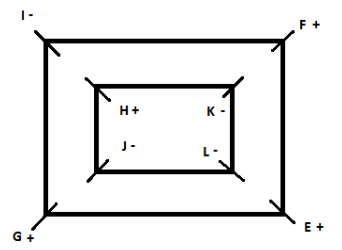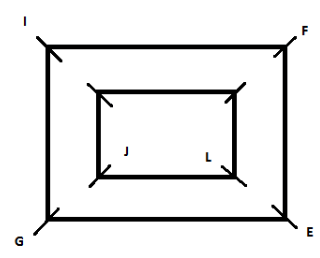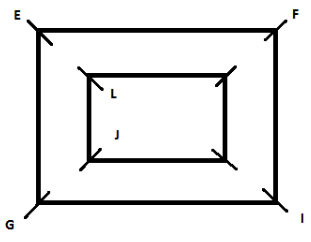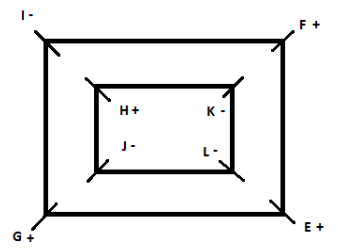SBI PO Mains Mock Test - 1 (New Pattern) - Bank Exams MCQ
30 Questions MCQ Test - SBI PO Mains Mock Test - 1 (New Pattern)
Directions: Study the information given below and answer the question based on it.
P, Q, R, S, T, U, V, W and X are nine persons sitting in three parallel rows facing north, in such a way that there is an equal distance between adjacent persons. Each row contains three positions. They have different boxes with different fruits such as Apple, Mango, Banana, Guava, Orange and Peach.
1. A person with Oranges sits in alignment with the persons who have Apples and Peaches.
2. Apples are in two boxes.
3. P sits to the immediate right of V in row 1.
4. U, R and P are sitting in different rows but are aligned diagonally with one another.
5. R has Apples in the box and the person to the second right of R has Peaches in the box.
6. X and Q are sitting in front of each other in rows 2 and 3.
7. V and T are diagonally opposite to each other and S sits in the 3rd row.
8. U and W have Peaches in their boxes.
9. A person who has Bananas in the box sits between the persons who have Apples and Peaches.
10. Q and a person who has Bananas are sitting diagonally opposite to each other.
11. Two persons with Mangoes and Guavas in boxes sit immediately next to each other, with a person who has Mangoes in the box being adjacent to a person with Peaches in the box.
Who sits to the left end of row 2?
Directions: Study the information given below and answer the question based on it.
P, Q, R, S, T, U, V, W and X are nine persons sitting in three parallel rows facing north, in such a way that there is an equal distance between adjacent persons. Each row contains three positions. They have different boxes with different fruits such as Apple, Mango, Banana, Guava, Orange and Peach.
1. A person with Oranges sits in alignment with the persons who have Apples and Peaches.
2. Apples are in two boxes.
3. P sits to the immediate right of V in row 1.
4. U, R and P are sitting in different rows but are aligned diagonally with one another.
5. R has Apples in the box and the person to the second right of R has Peaches in the box.
6. X and Q are sitting in front of each other in rows 2 and 3.
7. V and T are diagonally opposite to each other and S sits in the 3rd row.
8. U and W have Peaches in their boxes.
9. A person who has Bananas in the box sits between the persons who have Apples and Peaches.
10. Q and a person who has Bananas are sitting diagonally opposite to each other.
11. Two persons with Mangoes and Guavas in boxes sit immediately next to each other, with a person who has Mangoes in the box being adjacent to a person with Peaches in the box.
Who sits exactly to the right of the person who is sitting exactly in the front of V in the immediate next row?
Directions: Study the information given below and answer the question based on it.
P, Q, R, S, T, U, V, W and X are nine persons sitting in three parallel rows facing north, in such a way that there is an equal distance between adjacent persons. Each row contains three positions. They have different boxes with different fruits such as Apple, Mango, Banana, Guava, Orange and Peach.
1. A person with Oranges sits in alignment with the persons who have Apples and Peaches.
2. Apples are in two boxes.
3. P sits to the immediate right of V in row 1.
4. U, R and P are sitting in different rows but are aligned diagonally with one another.
5. R has Apples in the box and the person to the second right of R has Peaches in the box.
6. X and Q are sitting in front of each other in rows 2 and 3.
7. V and T are diagonally opposite to each other and S sits in the 3rd row.
8. U and W have Peaches in their boxes.
9. A person who has Bananas in the box sits between the persons who have Apples and Peaches.
10. Q and a person who has Bananas are sitting diagonally opposite to each other.
11. Two persons with Mangoes and Guavas in boxes sit immediately next to each other, with a person who has Mangoes in the box being adjacent to a person with Peaches in the box.
Who among the following sits in alignment with T and W?
Directions: Study the information given below and answer the question based on it.
P, Q, R, S, T, U, V, W and X are nine persons sitting in three parallel rows facing north, in such a way that there is an equal distance between adjacent persons. Each row contains three positions. They have different boxes with different fruits such as Apple, Mango, Banana, Guava, Orange and Peach.
1. A person with Oranges sits in alignment with the persons who have Apples and Peaches.
2. Apples are in two boxes.
3. P sits to the immediate right of V in row 1.
4. U, R and P are sitting in different rows but are aligned diagonally with one another.
5. R has Apples in the box and the person to the second right of R has Peaches in the box.
6. X and Q are sitting in front of each other in rows 2 and 3.
7. V and T are diagonally opposite to each other and S sits in the 3rd row.
8. U and W have Peaches in their boxes.
9. A person who has Bananas in the box sits between the persons who have Apples and Peaches.
10. Q and a person who has Bananas are sitting diagonally opposite to each other.
11. Two persons with Mangoes and Guavas in boxes sit immediately next to each other, with a person who has Mangoes in the box being adjacent to a person with Peaches in the box.
Who among the following has Apples in the box?
Study the following information carefully and answer the below questions.
Twenty persons are working in a bank at different designations- Chairman, Chief executive officer (CEO), managing director (MD), Manager and Clerk, where Chairman is the seniormost and clerk is the juniormost designation.
Note: The number of persons working in each position is one less than the number of persons working in their immediate junior position. If P works with Q, then P and Q are working in the same designation.
Even number of persons is senior to I. Odd number of persons working in G’s designation. The number of persons junior to G is one more than the number of persons senior to Z. E, Q and M are working in the same designation. The number of persons senior to M is the same as the number of persons working in the same designation where J works. J is junior to A. Even number of persons working in A’s designation. D is immediately junior to A and is working in senior position to Managing director. The number of persons senior to B is one less than the number of person junior to T.U is immediately senior to F, who is not working with I. O works as a clerk. H works with neither U nor Z. Both C and Y are immediately juniors to H but not working with B. Even number of persons working in N’s designation. Both S and L are senior to N.
All the persons except the persons who are designated as CEO are transferred to three departments viz. R&D, Sales and Legal as per the following conditions:
I. The person whose name starts with the letter which comes after “M” and also works with the person whose name starts with a vowel which comes before “M” in the alphabetical series are transferred to R&D department.
II. The persons whose name starts with the letter which comes before “M” and also even number of persons work along with the person, whose name starts with the letter which comes before “M” in the alphabetical series are transferred to Sales department.
III. The remaining persons are transferred to Legal department.
The persons who are working as CEO are assigned to the head of the three departments as per the condition given below.
The persons assigned to head of the R&D, Sales and Legal as per the reverse alphabetical order respectively.
What is the difference between the number of persons in the Legal and R&D departments?
Study the following information carefully and answer the below questions.
Twenty persons are working in a bank at different designations- Chairman, Chief executive officer (CEO), managing director (MD), Manager and Clerk, where Chairman is the seniormost and clerk is the juniormost designation.
Note: The number of persons working in each position is one less than the number of persons working in their immediate junior position. If P works with Q, then P and Q are working in the same designation.
Even number of persons is senior to I. Odd number of persons working in G’s designation. The number of persons junior to G is one more than the number of persons senior to Z. E, Q and M are working in the same designation. The number of persons senior to M is the same as the number of persons working in the same designation where J works. J is junior to A. Even number of persons working in A’s designation. D is immediately junior to A and is working in senior position to Managing director. The number of persons senior to B is one less than the number of person junior to T.U is immediately senior to F, who is not working with I. O works as a clerk. H works with neither U nor Z. Both C and Y are immediately juniors to H but not working with B. Even number of persons working in N’s designation. Both S and L are senior to N.
All the persons except the persons who are designated as CEO are transferred to three departments viz. R&D, Sales and Legal as per the following conditions:
I. The person whose name starts with the letter which comes after “M” and also works with the person whose name starts with a vowel which comes before “M” in the alphabetical series are transferred to R&D department.
II. The persons whose name starts with the letter which comes before “M” and also even number of persons work along with the person, whose name starts with the letter which comes before “M” in the alphabetical series are transferred to Sales department.
III. The remaining persons are transferred to Legal department.
The persons who are working as CEO are assigned to the head of the three departments as per the condition given below.
The persons assigned to head of the R&D, Sales and Legal as per the reverse alphabetical order respectively.
How many persons are working in the legal department whose name starts with a vowel and who is the head of the R&D department?
Study the following information carefully and answer the below questions.
Twenty persons are working in a bank at different designations- Chairman, Chief executive officer (CEO), managing director (MD), Manager and Clerk, where Chairman is the seniormost and clerk is the juniormost designation.
Note: The number of persons working in each position is one less than the number of persons working in their immediate junior position. If P works with Q, then P and Q are working in the same designation.
Even number of persons is senior to I. Odd number of persons working in G’s designation. The number of persons junior to G is one more than the number of persons senior to Z. E, Q and M are working in the same designation. The number of persons senior to M is the same as the number of persons working in the same designation where J works. J is junior to A. Even number of persons working in A’s designation. D is immediately junior to A and is working in senior position to Managing director. The number of persons senior to B is one less than the number of person junior to T.U is immediately senior to F, who is not working with I. O works as a clerk. H works with neither U nor Z. Both C and Y are immediately juniors to H but not working with B. Even number of persons working in N’s designation. Both S and L are senior to N.
All the persons except the persons who are designated as CEO are transferred to three departments viz. R&D, Sales and Legal as per the following conditions:
I. The person whose name starts with the letter which comes after “M” and also works with the person whose name starts with a vowel which comes before “M” in the alphabetical series are transferred to R&D department.
II. The persons whose name starts with the letter which comes before “M” and also even number of persons work along with the person, whose name starts with the letter which comes before “M” in the alphabetical series are transferred to Sales department.
III. The remaining persons are transferred to Legal department.
The persons who are working as CEO are assigned to the head of the three departments as per the condition given below.
The persons assigned to head of the R&D, Sales and Legal as per the reverse alphabetical order respectively.
Four of the following five are alike in a certain way based on the given arrangement and thus form a group. Which one of the following does not belong to the group?
Study the following information carefully and answer the below questions.
Twenty persons are working in a bank at different designations- Chairman, Chief executive officer (CEO), managing director (MD), Manager and Clerk, where Chairman is the seniormost and clerk is the juniormost designation.
Note: The number of persons working in each position is one less than the number of persons working in their immediate junior position. If P works with Q, then P and Q are working in the same designation.
Even number of persons is senior to I. Odd number of persons working in G’s designation. The number of persons junior to G is one more than the number of persons senior to Z. E, Q and M are working in the same designation. The number of persons senior to M is the same as the number of persons working in the same designation where J works. J is junior to A. Even number of persons working in A’s designation. D is immediately junior to A and is working in senior position to Managing director. The number of persons senior to B is one less than the number of person junior to T.U is immediately senior to F, who is not working with I. O works as a clerk. H works with neither U nor Z. Both C and Y are immediately juniors to H but not working with B. Even number of persons working in N’s designation. Both S and L are senior to N.
All the persons except the persons who are designated as CEO are transferred to three departments viz. R&D, Sales and Legal as per the following conditions:
I. The person whose name starts with the letter which comes after “M” and also works with the person whose name starts with a vowel which comes before “M” in the alphabetical series are transferred to R&D department.
II. The persons whose name starts with the letter which comes before “M” and also even number of persons work along with the person, whose name starts with the letter which comes before “M” in the alphabetical series are transferred to Sales department.
III. The remaining persons are transferred to Legal department.
The persons who are working as CEO are assigned to the head of the three departments as per the condition given below.
The persons assigned to head of the R&D, Sales and Legal as per the reverse alphabetical order respectively.
Who among the following person is the head of the Sales department?
Directions: Study the following information carefully and answer the question.
A hexagon has 6 equal sides in which a circle is inscribed and inside a circle, a triangle is inscribed.
Eight persons Prakash, Bumrah, Ravi, Dangi, Taplov, Farhan, Viladmir and Himesh are sitting around a circular table facing the centre at an equal distance starting with Bumrah on top centre. Circle, hexagon and triangle are arranged in a way such that corner A of the triangle is just below Bumrah and corner 1 of the hexagon is just above Bumrah. Each of them is wearing a shirt and a certain number is written on that. No one is wearing the shirt having same number. The corners of the triangle are named A, B and C in anticlockwise direction. Similarly, the corners of the hexagon are marked as 1, 2, 3, 4, 5 and 6 in clockwise direction.
The person wearing the shirt with number 58 sits second to the left of Dangi. Taplov sits immediately left of Prakash. Only one person sits between the one whose shirt numbers are 58 and 65. Dangi is wearing the shirt with even number. Ravi is not an immediate neighbour of Taplov. Only one person sits between the one whose shirt number is 65 and the one whose shirt number is 89. There are two persons sitting between Prakash and Dangi. There are three persons sitting between Ravi and Farhan. Three person sit between Viladmir and the one whose shirt number is 89. Prakash is wearing the shirt with number 12 more than that of Viladmir's shirt. The sum of the shirt numbers of Prakash and Ravi is 120. Prakash is not an immediate neighbour of the one whose shirt number is 58. Bumrah is not an immediate neighbour of Viladmir. Dangi gets shirt number 35 more than that of Taplov's shirt number. The one whose shirt number is 33 sits second to the left of the one whose shirt number is 31.
Now they start playing a game by throwing a dice. Bumrah throws a dice and changes his position according to the condition given below. Only one condition which is on priority follows. All throw dice in same order as given below, i.e first Bumrah, then Viladmir, then Prakash, and so on.
Conditions:
1. If the number on the dice is prime, then the person who gets it first moves to the hexagon at position 1 facing the centre, then the second person who gets it moves to position 3, similarly to position 5.
2. If the number on the dice is odd but nor prime, then the person who gets it first moves to the triangle at position A facing the centre, then the second person who gets it moves to position B, similarly to position C.
3. If the number on the dice is even but not prime, then the person who gets it remains at same position.
Throws:
1. Bumrah gets 3.
2. Viladmir gets 1.
3. Prakash gets 2.
4. Ravi gets 6.
5. Farhan gets 4.
6. Taplov gets 5.
7. Dangi gets 6.
8. Himesh gets 4.
What is the sum of the shirt numbers of the persons who are sitting on the corners of the hexagon after applying the conditions?
Directions: Study the following information carefully and answer the question.
A hexagon has 6 equal sides in which a circle is inscribed and inside a circle, a triangle is inscribed.
Eight persons Prakash, Bumrah, Ravi, Dangi, Taplov, Farhan, Viladmir and Himesh are sitting around a circular table facing the centre at an equal distance starting with Bumrah on top centre. Circle, hexagon and triangle are arranged in a way such that corner A of the triangle is just below Bumrah and corner 1 of the hexagon is just above Bumrah. Each of them is wearing a shirt and a certain number is written on that. No one is wearing the shirt having same number. The corners of the triangle are named A, B and C in anticlockwise direction. Similarly, the corners of the hexagon are marked as 1, 2, 3, 4, 5 and 6 in clockwise direction.
The person wearing the shirt with number 58 sits second to the left of Dangi. Taplov sits immediately left of Prakash. Only one person sits between the one whose shirt numbers are 58 and 65. Dangi is wearing the shirt with even number. Ravi is not an immediate neighbour of Taplov. Only one person sits between the one whose shirt number is 65 and the one whose shirt number is 89. There are two persons sitting between Prakash and Dangi. There are three persons sitting between Ravi and Farhan. Three person sit between Viladmir and the one whose shirt number is 89. Prakash is wearing the shirt with number 12 more than that of Viladmir's shirt. The sum of the shirt numbers of Prakash and Ravi is 120. Prakash is not an immediate neighbour of the one whose shirt number is 58. Bumrah is not an immediate neighbour of Viladmir. Dangi gets shirt number 35 more than that of Taplov's shirt number. The one whose shirt number is 33 sits second to the left of the one whose shirt number is 31.
Now they start playing a game by throwing a dice. Bumrah throws a dice and changes his position according to the condition given below. Only one condition which is on priority follows. All throw dice in same order as given below, i.e first Bumrah, then Viladmir, then Prakash, and so on.
Conditions:
1. If the number on the dice is prime, then the person who gets it first moves to the hexagon at position 1 facing the centre, then the second person who gets it moves to position 3, similarly to position 5.
2. If the number on the dice is odd but nor prime, then the person who gets it first moves to the triangle at position A facing the centre, then the second person who gets it moves to position B, similarly to position C.
3. If the number on the dice is even but not prime, then the person who gets it remains at same position.
Throws:
1. Bumrah gets 3.
2. Viladmir gets 1.
3. Prakash gets 2.
4. Ravi gets 6.
5. Farhan gets 4.
6. Taplov gets 5.
7. Dangi gets 6.
8. Himesh gets 4.
Who sits to the immediate left of Farhan after applying the conditions?
Directions: Study the following information carefully and answer the question.
A hexagon has 6 equal sides in which a circle is inscribed and inside a circle, a triangle is inscribed.
Eight persons Prakash, Bumrah, Ravi, Dangi, Taplov, Farhan, Viladmir and Himesh are sitting around a circular table facing the centre at an equal distance starting with Bumrah on top centre. Circle, hexagon and triangle are arranged in a way such that corner A of the triangle is just below Bumrah and corner 1 of the hexagon is just above Bumrah. Each of them is wearing a shirt and a certain number is written on that. No one is wearing the shirt having same number. The corners of the triangle are named A, B and C in anticlockwise direction. Similarly, the corners of the hexagon are marked as 1, 2, 3, 4, 5 and 6 in clockwise direction.
The person wearing the shirt with number 58 sits second to the left of Dangi. Taplov sits immediately left of Prakash. Only one person sits between the one whose shirt numbers are 58 and 65. Dangi is wearing the shirt with even number. Ravi is not an immediate neighbour of Taplov. Only one person sits between the one whose shirt number is 65 and the one whose shirt number is 89. There are two persons sitting between Prakash and Dangi. There are three persons sitting between Ravi and Farhan. Three person sit between Viladmir and the one whose shirt number is 89. Prakash is wearing the shirt with number 12 more than that of Viladmir's shirt. The sum of the shirt numbers of Prakash and Ravi is 120. Prakash is not an immediate neighbour of the one whose shirt number is 58. Bumrah is not an immediate neighbour of Viladmir. Dangi gets shirt number 35 more than that of Taplov's shirt number. The one whose shirt number is 33 sits second to the left of the one whose shirt number is 31.
Now they start playing a game by throwing a dice. Bumrah throws a dice and changes his position according to the condition given below. Only one condition which is on priority follows. All throw dice in same order as given below, i.e first Bumrah, then Viladmir, then Prakash, and so on.
Conditions:
1. If the number on the dice is prime, then the person who gets it first moves to the hexagon at position 1 facing the centre, then the second person who gets it moves to position 3, similarly to position 5.
2. If the number on the dice is odd but nor prime, then the person who gets it first moves to the triangle at position A facing the centre, then the second person who gets it moves to position B, similarly to position C.
3. If the number on the dice is even but not prime, then the person who gets it remains at same position.
Throws:
1. Bumrah gets 3.
2. Viladmir gets 1.
3. Prakash gets 2.
4. Ravi gets 6.
5. Farhan gets 4.
6. Taplov gets 5.
7. Dangi gets 6.
8. Himesh gets 4.
How many persons remain on the same position?
Directions: Study the following information carefully and answer the question.
A hexagon has 6 equal sides in which a circle is inscribed and inside a circle, a triangle is inscribed.
Eight persons Prakash, Bumrah, Ravi, Dangi, Taplov, Farhan, Viladmir and Himesh are sitting around a circular table facing the centre at an equal distance starting with Bumrah on top centre. Circle, hexagon and triangle are arranged in a way such that corner A of the triangle is just below Bumrah and corner 1 of the hexagon is just above Bumrah. Each of them is wearing a shirt and a certain number is written on that. No one is wearing the shirt having same number. The corners of the triangle are named A, B and C in anticlockwise direction. Similarly, the corners of the hexagon are marked as 1, 2, 3, 4, 5 and 6 in clockwise direction.
The person wearing the shirt with number 58 sits second to the left of Dangi. Taplov sits immediately left of Prakash. Only one person sits between the one whose shirt numbers are 58 and 65. Dangi is wearing the shirt with even number. Ravi is not an immediate neighbour of Taplov. Only one person sits between the one whose shirt number is 65 and the one whose shirt number is 89. There are two persons sitting between Prakash and Dangi. There are three persons sitting between Ravi and Farhan. Three person sit between Viladmir and the one whose shirt number is 89. Prakash is wearing the shirt with number 12 more than that of Viladmir's shirt. The sum of the shirt numbers of Prakash and Ravi is 120. Prakash is not an immediate neighbour of the one whose shirt number is 58. Bumrah is not an immediate neighbour of Viladmir. Dangi gets shirt number 35 more than that of Taplov's shirt number. The one whose shirt number is 33 sits second to the left of the one whose shirt number is 31.
Now they start playing a game by throwing a dice. Bumrah throws a dice and changes his position according to the condition given below. Only one condition which is on priority follows. All throw dice in same order as given below, i.e first Bumrah, then Viladmir, then Prakash, and so on.
Conditions:
1. If the number on the dice is prime, then the person who gets it first moves to the hexagon at position 1 facing the centre, then the second person who gets it moves to position 3, similarly to position 5.
2. If the number on the dice is odd but nor prime, then the person who gets it first moves to the triangle at position A facing the centre, then the second person who gets it moves to position B, similarly to position C.
3. If the number on the dice is even but not prime, then the person who gets it remains at same position.
Throws:
1. Bumrah gets 3.
2. Viladmir gets 1.
3. Prakash gets 2.
4. Ravi gets 6.
5. Farhan gets 4.
6. Taplov gets 5.
7. Dangi gets 6.
8. Himesh gets 4.
What is the number of the shirt of the person sitting at the triangle after applying the conditions?
Study the following information carefully and answer the below questions.
A certain number of persons are living in a building where The lowermost floor is numbered as 1 and the floor immediately above it is numbered as 2 and so on.
Note I: Each floor has two flats viz. Flat A and Flat B where Flat A is to the west of Flat B.
Note II: Flat A of floor 2 is immediately above flat A of floor 1 and immediately below Flat A of Floor 3 and so on, similarly for Flat B.
Only three floors are between K and H, who lives southwest of S. Only one floor is there between S and H. K and S are living in different flats. Q lives two floors above K. Q lives northwest of L. Only two floors are between S and L. I lives three floors above L and both are living in the same flat. T lives east of M. P lives southeast of H who lives north of M. P does not live on the adjacent floor of T. Not more than one floor is between H and P. Not more than two floors are between P and M. As many floors between S and P as between P and T. As many floors above Q as below V who lives southwest of P. V lives above M but not immediately above M. T lives on the bottommost floor.
Which of the following statement(s) is/are not true?
I. Only three floors are between K and P
II. V lives on the third floor
III. T lives southeast of H
Study the following information carefully and answer the below questions.
A certain number of persons are living in a building where The lowermost floor is numbered as 1 and the floor immediately above it is numbered as 2 and so on.
Note I: Each floor has two flats viz. Flat A and Flat B where Flat A is to the west of Flat B.
Note II: Flat A of floor 2 is immediately above flat A of floor 1 and immediately below Flat A of Floor 3 and so on, similarly for Flat B.
Only three floors are between K and H, who lives southwest of S. Only one floor is there between S and H. K and S are living in different flats. Q lives two floors above K. Q lives northwest of L. Only two floors are between S and L. I lives three floors above L and both are living in the same flat. T lives east of M. P lives southeast of H who lives north of M. P does not live on the adjacent floor of T. Not more than one floor is between H and P. Not more than two floors are between P and M. As many floors between S and P as between P and T. As many floors above Q as below V who lives southwest of P. V lives above M but not immediately above M. T lives on the bottommost floor.
Who among the following person is living on the fourth floor of flat A?
Study the following information carefully and answer the below questions.
A certain number of persons are living in a building where The lowermost floor is numbered as 1 and the floor immediately above it is numbered as 2 and so on.
Note I: Each floor has two flats viz. Flat A and Flat B where Flat A is to the west of Flat B.
Note II: Flat A of floor 2 is immediately above flat A of floor 1 and immediately below Flat A of Floor 3 and so on, similarly for Flat B.
Only three floors are between K and H, who lives southwest of S. Only one floor is there between S and H. K and S are living in different flats. Q lives two floors above K. Q lives northwest of L. Only two floors are between S and L. I lives three floors above L and both are living in the same flat. T lives east of M. P lives southeast of H who lives north of M. P does not live on the adjacent floor of T. Not more than one floor is between H and P. Not more than two floors are between P and M. As many floors between S and P as between P and T. As many floors above Q as below V who lives southwest of P. V lives above M but not immediately above M. T lives on the bottommost floor.
How many floors are in the building?
Directions: Study the following information carefully and answer the question.
Four married couples viz. E, F, G, H, I, J, K and L, not necessarily in same order, are sitting along two concentric squares. All the persons are sitting exactly at the corners of the squares. The persons sitting in the outer square are facing the centre and the persons sitting in the inner square are facing outside. Married couples are facing each other. (If A is married to B, then both are sitting in different squares and they face each other.)
No female sits to the immediate right of G. Among K and E, one is not a female. I and E are sitting in the outer square. H is a male. L and E are married to each other. F is not an immediate neighbour of G and sits in the outer square. J, who is not sitting in the outer square, is married to G. The immediate neighbours of L are females.
Find the odd one out.
Directions: Study the following information carefully and answer the question.
Four married couples viz. E, F, G, H, I, J, K and L, not necessarily in same order, are sitting along two concentric squares. All the persons are sitting exactly at the corners of the squares. The persons sitting in the outer square are facing the centre and the persons sitting in the inner square are facing outside. Married couples are facing each other. (If A is married to B, then both are sitting in different squares and they face each other.)
No female sits to the immediate right of G. Among K and E, one is not a female. I and E are sitting in the outer square. H is a male. L and E are married to each other. F is not an immediate neighbour of G and sits in the outer square. J, who is not sitting in the outer square, is married to G. The immediate neighbours of L are females.
Who is married to K?
Directions: Study the following information carefully and answer the question.
Four married couples viz. E, F, G, H, I, J, K and L, not necessarily in same order, are sitting along two concentric squares. All the persons are sitting exactly at the corners of the squares. The persons sitting in the outer square are facing the centre and the persons sitting in the inner square are facing outside. Married couples are facing each other. (If A is married to B, then both are sitting in different squares and they face each other.)
No female sits to the immediate right of G. Among K and E, one is not a female. I and E are sitting in the outer square. H is a male. L and E are married to each other. F is not an immediate neighbour of G and sits in the outer square. J, who is not sitting in the outer square, is married to G. The immediate neighbours of L are females.
Who sits second to the right of G's spouse?
Study the following information carefully and answer the questions given below
Input: 4825 7395 2946 5238 9472 6439
Step I: 8741 5691 4983 1467 9854 3869
Step II: 828 554 1272 724 3640 2748
Step III: 3640 1272 554 724 828 2748
Step IV: 61 58 66 69 132 133
Step V: 122 116 132 138 264 266
Step VI: 831 662 611 462 231 221
Step VI gives the final output.
Input: 5738 8371 2594 6285 3689 9472
What is the difference between the third highest number in step III and the second lowest in step V?
Study the following information carefully and answer the questions given below
Input: 4825 7395 2946 5238 9472 6439
Step I: 8741 5691 4983 1467 9854 3869
Step II: 828 554 1272 724 3640 2748
Step III: 3640 1272 554 724 828 2748
Step IV: 61 58 66 69 132 133
Step V: 122 116 132 138 264 266
Step VI: 831 662 611 462 231 221
Step VI gives the final output.
Input: 5738 8371 2594 6285 3689 9472
If 4198 is related to 1567 in step I, 328 is related to 3640 in step III in a certain way, then 221 is related to which of the following number in step VI?
In March 2025, Which of the following statements regarding the Vigyan Dhara Scheme launched by the Ministry of Science & Technology is/are correct?
1. The scheme is aimed at strengthening India’s scientific research, innovation, and technological development.
2. The outlay for the Vigyan Dhara scheme is ₹10,579.84 crore, with an increased annual allocation for the year 2025-26.
3. Vigyan Dhara merges three existing umbrella schemes into one, focusing on human capacity building in research and development.
In May 2025, the government of India gifted 15 Electric Vehicles (EVs) to Nepal as part of efforts to promote climate change dialogue. The EVs were meant to support logistical arrangements for a global summit focused on climate change and mountain ecosystems. What is the name of the dialogue for which the EVs were gifted?
In April 2025, the Reserve Bank of India (RBI) launched three surveys on April 29, 2025, aimed at gathering insights to guide its monetary policy decisions. One of these surveys focuses on urban households, assessing their views on the general economic situation, employment, and income levels. What is the name of this survey?
In April 2025, the President of India, Draupadi Murmu, gave assent to the ‘Immigration and Foreigners Bill, 2025,’ which addresses issues related to immigration and foreigners in India. Which of the following penalties are included in the new law for foreign nationals entering India without proper documentation?
In May 2025, the Ministry of Mines of India released provisional data highlighting record production achievements in key mineral sectors during FY25, including substantial increases in iron ore, manganese ore, and bauxite production compared to FY24 levels. Which of the following minerals recorded a production of 289 million metric tons (MMT) in FY25, marking a 4.3% growth over the previous year?
In April 2025, In a major defence procurement initiative, India signed a deal worth approximately Rs 64,000 crore with France in April 2025 for purchasing fighter jets to bolster the Indian Navy's air combat capabilities. This deal includes 26 Rafale-M fighter jets, which will be operated from the country’s indigenous aircraft carrier. What is the name of the aircraft carrier these jets will operate from?
In March 2025, As per the findings of RBI’s 6th Round of India’s Remittances Survey (2023-24), which of the following statements is/are correct?
1. The USA was the top remittance source country for India in FY24.
2. The total remittances received by India in FY24 stood at USD 108.7 billion.
3. Maharashtra and Kerala accounted for the highest remittance inflows among Indian states.
In April 2025, the Telangana government signed a tripartite agreement with two Japanese IT firms to establish an AI Data Centre Cluster in Hyderabad. The investment for this project is Rs 10,500 crore. Which of the following companies is involved in this project?
In May 2025, the Ministry of Agriculture & Farmers Welfare launched a nationwide campaign to enhance technology adoption in agriculture and aquaculture. The 15-day campaign aims to connect farmers with scientific innovations across 731 KVKs and 113 ICAR institutes. What is the name of this campaign?
In April 2025, the Government of India has designated several banks and financial institutions as corporate agents in Gujarat International Finance Tec-City (GIFT City). These entities are now authorised to sell insurance products to Non-Resident Indians (NRIs) and Persons of Indian Origin (PIOs) worldwide, significantly expanding their offerings and reach in global markets. Which of the following banks has been designated as a corporate agent in GIFT City, enabling it to offer insurance products to NRIs and PIOs?





